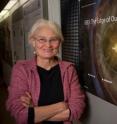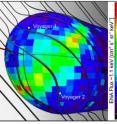Satellite reveals surprising cosmic 'weather' at edge of solar system
The first solar system energetic particle maps show an unexpected landmark occurring at the outer edge of the solar wind bubble surrounding the solar system. Scientists published these maps, based mostly on data collected from NASA's Interstellar Boundary Explorer satellite, in the Oct. 15 issue of Science Express, the advance online version of the journal Science. "Nature is full of surprises, and IBEX has been lucky to discover one of those surprises," said Priscilla Frisch, a senior scientist in astronomy & astrophysics at the University of Chicago. "The sky maps are dominated by a giant ribbon of energetic neutral atoms extending throughout the sky in an arc that is 300 degrees long." Energetic neutral atoms form when hot solar wind ions (charged particles) steal electrons from cool interstellar neutral atoms.
IBEX was launched Oct. 19, 2008, to produce the first all-sky maps of the heliosphere, which reaches far beyond the solar system's most distant planets. Extending more than 100 times farther than the distance from Earth to the sun, the heliosphere marks the region of outer space subjected to the sun's particle emissions.
The new maps show how high-speed cosmic particle streams collide and mix at the edge of the heliosphere, said Frisch, who co-authored three of a set of IBEX articles appearing in this week's Science Express. The outgoing solar wind blows at 900,000 miles an hour, crashing into a 60,000-mile-an-hour "breeze" of incoming interstellar gas.
Revealed in the IBEX data, but not predicted in the theoretical heliosphere simulations of three different research groups, was the ribbon itself, formed where the direction of the interstellar magnetic field draping over the heliosphere is perpendicular to the viewpoint of the sun.
Energetic protons create forces as they move through the magnetic field, and when the protons are bathed in interstellar neutrals, they produce energetic neutral atoms. "We're still trying to understand this unexpected structure, and we believe that the interstellar magnetic forces are associated with the enhanced ENA production at the ribbon," Frisch said.
IBEX shows that energetic neutral atoms are produced toward the north pole of the ecliptic (the plane traced by the orbit of the planets around the sun), as well as toward the heliosphere tail pointed toward the constellations of Taurus and Orion. "The particle energies change between the poles and tail, but surprisingly not in the ribbon compared to adjacent locations," Frisch said.
Source: University of Chicago
Articles on the same topic
- Cassini helps redraw shape of solar systemFri, 16 Oct 2009, 13:58:10 UTC
- NASA spacecraft provides first view of our place in the galaxyThu, 15 Oct 2009, 20:26:16 UTC
- IBEX satellite finds ribbon-like structure at edge of heliosphereThu, 15 Oct 2009, 19:16:15 UTC
- First IBEX maps reveal fascinating interactions occurring at the edge of the solar systemThu, 15 Oct 2009, 18:41:17 UTC
Other sources
- First IBEX Maps Reveal Fascinating Interactions Occurring At The Edge Of The Solar Systemfrom Science DailyFri, 16 Oct 2009, 19:14:30 UTC
- IBEX Satellite Finds Ribbon-like Structure At Edge Of Heliospherefrom Science DailyFri, 16 Oct 2009, 19:14:29 UTC
- Satellite reveals surprising cosmic 'weather' at edge of solar systemfrom Science BlogFri, 16 Oct 2009, 18:14:15 UTC
- Cassini helps redraw shape of solar systemfrom Science BlogFri, 16 Oct 2009, 15:35:48 UTC
- Cassini Data Help Redraw Shape of Solar System (w/ Video)from PhysorgFri, 16 Oct 2009, 15:35:12 UTC
- New View Of The Heliosphere: Cassini Helps Redraw Shape Of Solar Systemfrom Science DailyFri, 16 Oct 2009, 15:28:11 UTC
- Bursting the sun's bubblefrom MIT ResearchFri, 16 Oct 2009, 8:21:09 UTC
- NASA spacecraft provides first view of our place in the galaxyfrom Science BlogThu, 15 Oct 2009, 20:49:26 UTC
- Spacecraft obtains new view of our galaxyfrom UPIThu, 15 Oct 2009, 19:21:39 UTC
- First IBEX maps reveal fascinating interactions occurring at the edge of the solar systemfrom Science BlogThu, 15 Oct 2009, 19:21:30 UTC
- Catching The Interstellar Wind: Spacecraft Provides First View Of Our Place In The Galaxyfrom Science DailyThu, 15 Oct 2009, 19:07:05 UTC
- Glimpses of Solar System's edgefrom BBC News: Science & NatureThu, 15 Oct 2009, 18:35:27 UTC
- Scientists Explore Galactic Frontier, Release First-Ever All-Sky Map (w/ Video)from PhysorgThu, 15 Oct 2009, 18:35:16 UTC
- Mystery Emissions Spotted at Edge of Solar Systemfrom Space.comThu, 15 Oct 2009, 18:28:05 UTC

